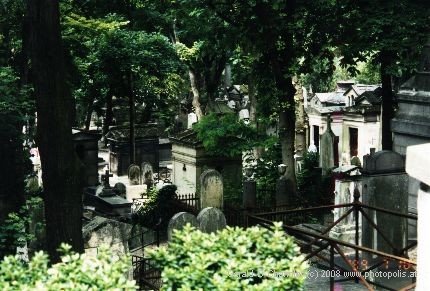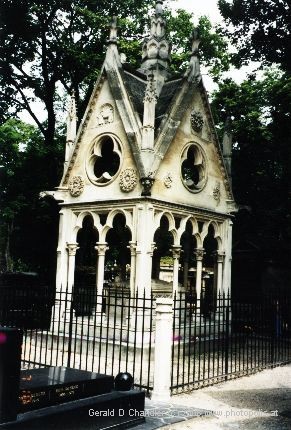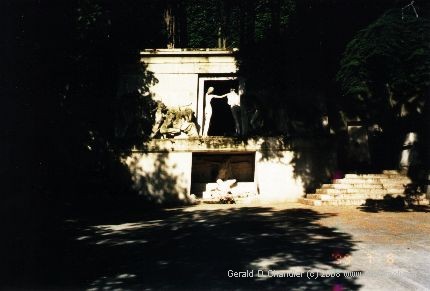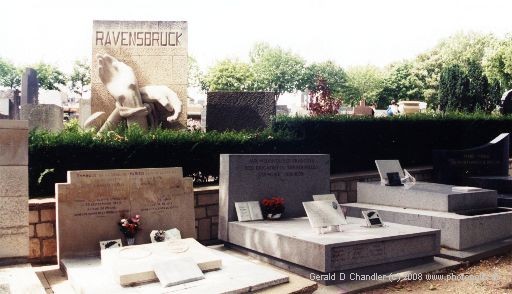Home | Front Page | Index | Blog | New | Contact | Site Map
Paris 1999 | Maps | Pics Day-by-day
Tourism
Daily Life
71 Rue de La Mare
Belleville
Computers
Metro
Objets Trouvés
Events
Gerry's Sketch
Hen Party
Jan's Birthday
Tour de France
Outings
Outside Paris
Fontainebleau
Giverny & West
Solar Eclipse
Versailles
Paris 1999
Paris 2005
Paris 2007
France 2007
Paris 2008
France 2008

Britain 1999
Beijing 1999
China 1999
Hong Kong 1999
Vietnam 2000
China 2000

Alley of trees in Père Lachaise |
We don’t usually think of visiting a cemetery as being a normal tourist thing to do, but there are a surprisingly high number of cities where it is done. In Los Angeles there is Forest Lawn, the last resting place of many movie stars. And, of course, Arlington National Cemetery is part of the Washington, DC tourist circuit. In London Highgate Cemetery is the site of the remains of and a statue to Karl Marx. While not a cemetery, Westminster Abbey is also visited for the remains it holds.

Greenery in Père Lachaise |
Cemeteries are also the goal of tourists in Paris. The most famous and most visited of all is the Père Lachaise cemetery, only a 15-minute walk from where we live. It opened in 1804 on the site of the former country home of Abbot Lachaise, about 3 miles from the center of Paris. At that time official Paris was hardly two miles from west to east and so it was well outside the city. In the middle ages most burials were done in church yards. Because of poor drainage there were often noxious after effects to burials. The result was that all cemeteries were banned within the city. As the city grew it once again had cemeteries within its bounds. Closing and moving of cemeteries has happened several times, but Père Lachaise, Montmartre, and Montparnasse are so recent and so large that they are almost certain to remain where they are.
We’ve been to Père Lachaise four times. Because our first visit was interesting we went back and also made brief forays into the Montparnssse and Montmartre cemeteries, both names more usually associated with struggling artists and Bohemia. In fact, today, all three cemeteries are interesting for the famous people who lie there and for the chance to have some breathing room; some greenery in an otherwise very dense Paris. One can find the graves or ex-graves of Chopin, Zola, and hundreds of other greats and lesser greats. (Those French citizens at the acme of fame like Zola are not found in these cemeteries; they have been moved to the Pantheon.)
It is an interesting question which came first: tourists visiting these cemeteries and then their being included in guides or their being in guides and tourists following. It must be a mixture: those in the know would certainly search out the graves of their favorites. This is certainly the case of Chopin and Jim Morrison of The Doors. On the other hand, those like us, walking about completely unaware of most of these people, learn about them from visiting the cemeteries.
We’d been in Paris over a week and had spent most of the day at home when we first walked over to Père Lachaise. It sits on the eastern slope of the Paris basin, as does Belleville. It is slightly larger than the Parc Buttes-Chaumont, both being about 80 acres (1/10 of New York City's Central Park). It is nearly due south from where we live, so we walked the smaller streets and came in at the eastern, or back entrance.

Lachaise Entry |
The main or west entrance of Père LaChaise is on Blvd de Belleville, but we weren’t to see it until our second visit. This photo shows Jan and Mike Eddy as they are about to enter by the west gate on our fourth visit.
Our first visit was pretty short as we came in about 5:00 p.m. and the cemetery closes at 6:00 p.m. Just as we were getting to know our way about we were told to leave. We don’t have the pictures Gerry took that day, because he lost his camera with the pictures in it, undeveloped.
Before our second visit we went to the Belleville library, got library cards, and, among other books, checked out a guide to Père Lachaise ("Au Père Lachaise" by Michel Dansel) that listed and described at least a thousand graves. Well equipped for our second visit we decided to go early.

Tomb of Abélard and Héloise |
As usual, we didn’t get out of the flat before 11:00 and because we walked along busy Blvd de Belleville toward the main entrance we got delayed: we passed a half dozen Jewish-Moroccan restaurants and elected to first have lunch at one of them. Gerry had his second Couscous in nearly twenty years while Jan chose to learn what a Tagine was by ordering one. Somehow Gerry always likes what Jan orders better than what he ordered. A couscous is a highly spiced stew of vegetables and meats served with accomanying semolina. A tagine has many of the same ingredients but adds olives, lemon, oils, and fewer hot spices.
Père Lachaise is filled with trees and green alleys. Being nearly two hundred years old there has been adequate time for the trees to mature. The two photos at the beginning of this page present one of the aspects of the cemetery that Gerry likes best. Some graves are nicely aligned on broad avenues; others are reached by the narrowest of paths.
On our third visit, after inquiring about Gerry’s lost camera, we saw the graves of Abelhard and Heloise. These lovers of the twelfth century were moved here twenty years after the opening of the cemetery in order to make it more prestigious and attract site purchasers.

Monument aux Morts |
In France most gravesites are not permanent: they are leased for fifty or one hundred years. When the lease ends, the site is emptied and after a period made available to another. The bones are moved to an ossuary; that in Père Lachaise is said to contain two million remains. The entrance to this "Monument aux Morts", left, shows naked lovers accompanying each other to enternity. It is an image that shocked many when it was originally put in place.
On reflection making the grave sites available to others after a long period is a reasonable system: No one in our families has any idea who their ancestors dead 100 years are or where they are buried. We certainly don’t visit their graves.
If a grave is to be occupied permanently in France it is marked "C. A. P." or "Cédé a perpétuité" (Assigned perpetually). As a rough guess, fewer than half of the graves are so marked.

Near Jim Morrison's Grave |
By far the most famous current resident, or at least the one who attracts crowds is Jim Morrison. Neither of us had much of an idea who he was, not having listened to his music when he was alive. But plenty of people did and plenty more, too young to have heard him when he was alive, have an active interest in him. Since our visitor Mike Eddy wanted to see his grave we made a fourth visit. Jim Morrison’s grave was marked by a large crowd.
By co-incidence, the Sunday Figaro Magazine for August 14 has an article about Morrison. It let Gerry learn a little and, as we can assume the editors know best, it shows what interests the French.
After seeing the Morrison grave, we walked to the south-east side, which could be called Memorial Way. There we found a dozen or more monuments to the victims of the Nazi holocaust. They were nearly unvisited, and certainly not mentioned in the tourist guides. Nearby was the monument to the "Fusillées" – the last fighters of the Paris Commune of 1870 who met the firing squad at a wall of the cemetery. The only visitors besides us were a Chinese tour group, presumably visiting in memory of the origins of communism.

Memorial to the Victims of Ravensbruck |